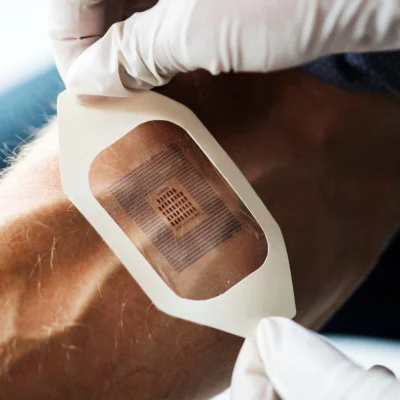An overview of novel medical devices, from an implanted simulator for better sensation of balance to robotic clothing and sensor-based asthma inhalers.
You might also like:Researchers have
developed a microneedle patch for the collection and analysis of biomarkers in
interstitial fluid as a minimally invasive alternative to blood tests.
Learn
more
Vestibular Implant for Balance
Researchers at Johns Hopkins Medicine have adjusted a cochlear implant to stimulate the vestibular nerve (instead of cochlear nerve for hearing restoration) according to an external motion sensor’s electric signals. The signals bypass the malfunctioning parts of inner ear to convey information about the speed and direction of the patient’s head movements. The device was tested on eight volunteers and showed to improve walking, movement and orientation in space as well as reduce dizziness during those. At the same time, the patients reported hearing loss of a varying degree in the implanted ear.
Epidermal Patch for Biomarkers Monitoring
A stamp-sized stretchy skin patch developed at the University of California San Diego allows for the simultaneous monitoring of haemodynamic and metabolic biomarkers, such as blood pressure, heart rate as well as levels of glucose, lactate, alcohol, or caffeine. This is the first wearable device that can track both cardiovascular signals and multiple biochemical levels in a human body at once. Its applications may include monitoring individuals with diabetes, or detecting the onset of sepsis in ICU patients.
Robotic Clothing for People with Disabilities
A team at
the University of Bristol demonstrated a
new electro-pneumatic pump for soft robots, which may facilitate further
development of assistive clothing with inflated artificial pneumatic muscles. Current
electromagnetic pumps are complex and expensive, while the new pump is soft,
bendable and low-cost. Wearable devices such as robotic clothing could
facilitate movement for people with disabilities or muscle degeneration.
Asthma Inhalers for Improved Symptom Control
Researchers from Northwestern and Lurie Children's Hospital conducted a 12-months trial of sensor-based asthma inhalers in 252 children. The study deployed Bluetooth-connected sensors attached to devices, for medication use monitoring and sharing the data with clinicians. The findings show that these sensors may help with treatment adherence, detect asthma symptoms in advance and generally improve the quality of life for asthma patients and their caregivers.
Microfluidic Chip for COVID-19 Testing
A team of engineers from Rice University created a chip that in combination with a diagnostic tool on a smartphone can diagnose COVID-19 in less than an hour. The chip measures a biomarker for the disease (SARS-CoV-2 nucleocapsid protein) in blood serum by binding blood drawn from a finger stick blood test with nanobeads. This allows to detect the biomarker with an electrochemical sensor (potentiostat) connected to a smartphone in a non-laboratory setting and faster than with commonly used COVID-19 tests.
Image credit: Rawpixel
via iStock









